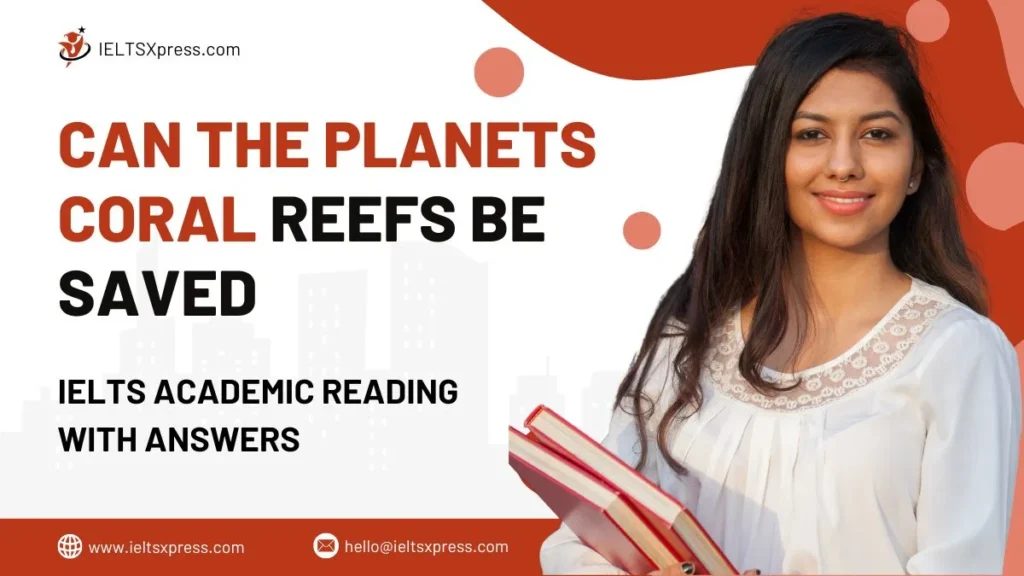Can the Planets Coral Reefs be Saved IELTS Reading with Answers
Can the Planet’s Coral Reefs Be Saved IELTS Reading with Answers is a powerful passage featured in the IELTS Academic Reading Test. It focuses on the environmental crisis facing coral reefs around the world, the causes of reef degradation, and the scientific efforts being made to preserve these vital ecosystems. This passage tests a range of reading skills, including understanding detailed factual information, identifying opinions, and following logical arguments.
In this article, we break down the passage, provide sample questions, and include accurate answers to help you prepare confidently for the IELTS Reading section.
READING PASSAGE 2
You should spend about 20 minutes on Question 14-26 which are based on Reading Passage 2 below.
Can the Planets Coral Reefs be Saved
Questions 14-19
Reading Passage 2 has six paragraphs, A-F.
Choose the correct heading for each paragraph from the list of headings below.
Write the correct number, i—x, in boxes 14-19 on your answer sheet.
List of Headings
i Tried and tested solutions
ii Cooperation beneath the waves
iii Working to lessen the problems
iv Disagreement about the accuracy of a certain phrase
v Two clear educational goals
vi Promoting hope
vii A warning of further trouble ahead
14 Paragraph A
15 Paragraph B
16 Paragraph C
17 Paragraph D
18 Paragraph E
19 Paragraph F
A Conservationists have put the final touches to a giant artificial reef they have been assembling at the world-renowned Zoological Society of London (London Zoo). Sample soft he planet’s most spectacular corals – vivid green branching coral, yellow scroll, blue ridge and many more species – have been added to the giant tank along with fish that thrive in their presence: blue tang, clownfish and many others. The reef is in the zoo’s new gallery, Tiny Giants, which is dedicated to the minuscule invertebrate creatures that sustain life across the planet. The coral reef tank and its seven-metre-wide window form the core of the exhibition.
‘Coral reefs are the most diverse ecosystems on Earth and we want to show people how wonderful they are,’ said Paul Pearce-Kelly, senior curator of invertebrates and fish at the Zoological Society of London. ‘However, we also want to highlight the research and conservation efforts that are now being carried out to try to save them from the threat of global warming.’ They want people to see what is being done to try to save these wonders.
B Corals are composed of tiny animals, known as polyps, with tentacles for capturing small marine creatures in the sea water. These polyps are transparent but get their brilliant tones of pink, orange, blue, green, etc. from algae that live within them, which in turn get protection, while their photosynthesising of the sun’s rays provides nutrients for the polyps. This comfortable symbiotic relationship has led to the growth of coral reefs that cover 0.1%of the planet’s ocean bed while providing homes for more than 25% of marine species, including fish, molluscs, sponges and shellfish.
C As a result, coral reefs are often described as the ‘rainforests of the sea’, though the comparison is dismissed by some naturalists, including David Attenborough. ‘People say you can not beat the rainforest,’ Attenborough has stated. ‘But that is simply not true. You go there and the first thing you think is: where … are the birds? Where are the animals? They are hiding in the trees, of course. No, if you want beauty and wildlife, you want a coral reef. Put on a mask and stick your head under the water. The sight is mind-blowing.’
D Unfortunately, these majestic sights are now under very serious threat, with the most immediate problem coming in the form of thermal stress. Rising ocean temperatures are triggering bleaching events that strip reefs of their colour and eventually kill them. And that is just the start. Other menaces include ocean acidification, sea level increase, pollution by humans, deoxygenation and ocean current changes, while the climate crisis is also increasing habitat destruction. As a result, vast areas – including massive chunks of Australia’s Great Barrier Reef – have already been destroyed, and scientists advise that more than90%ofreefs could be lost by 2050 unless urgent action is taken to tackle global heating and greenhouse gas emissions.
Pearce-Kelly says that coral reefs have to survive really harsh conditions – wave erosion and other factors. And ‘when things start to go wrong in the oceans, then corals will be the first to react. And that is exactly what we are seeing now. Coral reefs are dying and they are telling us that all is not well with our planet.’
E However, scientists are trying to pinpoint hardy types of coral that could survive our overheated oceans, and some of this research will be carried out at London Zoo. ‘Behind our … coral reef tank we have built laboratories where scientists will be studying coral species,’ said Pearce-Kelly. One aim will be to carry out research on species to find those that can survive best in warm, acidic waters. Another will be to try to increase coral breeding rates. ‘Coral spawn just once a year,’ he added. ‘However, aquarium-based research has enabled some corals to spawn artificially, which can assist coral reef restoration efforts. And if this can be extended for all species, we could consider the launching of coral-spawning programmes several times a year. That would be a big help in restoring blighted reefs.’
F Research in these fields is being conducted in laboratories around the world, with the London Zoo centre linked to this global network. Studies carried out in one centre can then be tested in others. The resulting young coral can then be displayed in the tank in Tiny Giants. ‘The crucial point is that the progress we make in making coral better able to survive in a warming world can be shown to the public and encourage them to believe that we can do something to save the planet’s reefs,’ said Pearce-Kelly. ‘Saving our coral reefs is now a critically important ecological goal.’
Questions 20 and 21
Choose TWO letters, A-E. Write the correct letters in boxes 20 and 21 on your answer sheet.
Which TWO of these causes of damage to coral reefs are mentioned by the writer of the text?
A arising number of extreme storms
B the removal of too many fish from the sea
C the contamination of the sea from waste
D increased disease among marine species
E alterations in the usual flow of water in the seas
Questions 22 and 23
Choose TWO letters, A-E.
Write the correct letters in boxes 22 and 23 on your answer sheet.
Which TWO of the following statements are true of the researchers at London Zoo?
A They are hoping to expand the numbers of different corals being bred in laboratories.
B They want to identify corals that can cope well with the changed sea conditions.
C They are looking at ways of creating artificial reefs that corals could grow on.
D They are trying out methods that would speed up reproduction in some corals.
E They are investigating materials that might protect reefs from higher temperatures
Questions 24–26
Complete the sentences below.
Choose ONE WORD ONLY from the passage for each answer.
Write your answers in boxes 24–26 on your answer sheet.
24. Corals have a number of ___________ which they use to collect their food.
25. Algae gain ___________ from being inside the coral.
26. Increases in the warmth of the sea water can remove the ___________ from coral.
Can the Planets Coral Reefs be Saved Reading Answers
14. v
15. ii
16. iv
17. vii
18. iii
19. vi
20. CE
21. CE
22. BD
23. BD
24. tentacles
25. protection
26. colour
Also Practice: Frozen Food IELTS Reading with Answers



